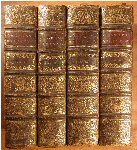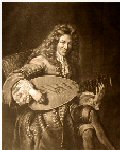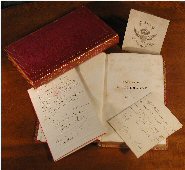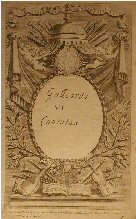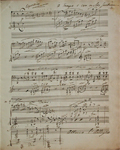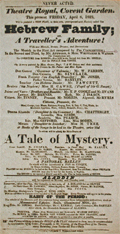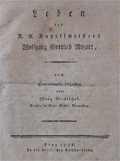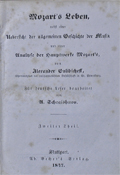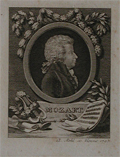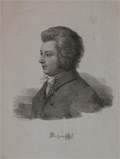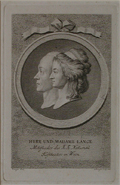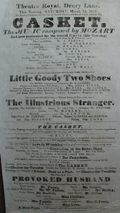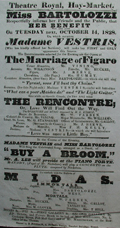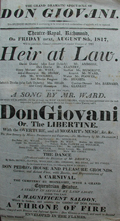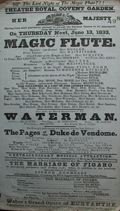Associate: Dr. Ulrich Drüner
at home in Oxford, on December 18th 2007, 4 months short of her 99th birthday.
The following special offer to mark Mozart’s birthday is also a tribute to Maud
and to her 53-year involvement with Otto Haas.

Maud Rosenthal at her office on October 5th 2007
|
|
||
| A) Some fictitious works by Mozart (and Haydn) | ||
|
[MOZART, Wolfgang Amadeus, ascribed to] – EBERL, Anton (1765–1807). XII Variations pour Clavecin ou Piano Forte par W. A. Mozart. Vienna, Magazin de Musique dans l’Unterbreuner- KV Anh. C. 26.04 (Anh. 286); not in BUC; RISM E 152 (only 1 complete copy [US] and 1 incomplete [D]). – First edition of this interesting set of variations, which was re-published four years later by Artaria and André, both, once again, using the wrong composer’s name. Commerce linked with celebrated names is not a modern invention . After Mozart’s death, “newly discovered” works of the great composer soon started circulating, among them several works of Mozart’s very gifted friend, Anton Eberl, who declared in the Hamburger unpartheische Correspondent that four of his works, published under Mozart’s name, were his own and that he had nothing to do with such a fraud. However, these editions continued circulating from Eberl used Dittersdorf’s arietta „Freundin sanfter Herzenstriebe“ as the theme (from the comic opera Der Schiffspatron, oder: Der neue Gutsherr, premiered in Eberl lived mainly in Order no. 0801S001 £ 280 |
||
|
A book Mozart never wrote! MOZART, W. A. (attributed). Kurzgefasste Generalbass-Schule. Vienna, S. A. Steiner und Comp. [1817]. 8vo. Pp. 55. Contemporary boards (spine defective) with the original publisher’s blue printed wrappers bound in; foxing to covers. From the library of Alfred Cortot with his bookplate.
Köchel C 30.04 (Anh. 109d). A Joseph Haydenreich first offered the manuscript of this tutor in the Wiener Zeitung of 13 April 1796 as ‘a still unknown written primer for learning the figured bass’. Köchel says that this manuscript may have been the source for this first edition. Mozart certainly did not write this work but it is possible that it was based on composition studies by his pupils. The Vienna National Library owns such a manuscript deriving from a relative of Abbé Stadler, giving an idea of Mozart’s teaching methods and his pertinent annotations. Even if the authenticity is not definitive, this work is interesting and typical of Mozart’s time.
Order no. 0801S002 £ 380 |
||
|
MOZART, Wolfgang Amadeus (1756–1791) [ascribed to]. ANLEITUNG. Englische Contretänze mit zwei Würfeln zu componiren so viele man will, ohne etwas von der Musik oder der Composition zu verstehen. [...] INSTRUCTION To compose without the least knowledge of Music as many Country dances as one pleases, by throwing a certain Number with two Dice. Köchel, Anh. C.30.01; RISM MM7225a (only 1 copy [US-R]), extremely rare indeed. Simrock published an analogue method for composing Walzer or Schleifer (Pl.-No. 48, RISM M 7226), which is more common (9 copies in RISM). This “method” had been ascribed to different composers, but most known editions (RISM M 7224-7228 and MM 7225a-7226a) link this work with Mozart’s name, which was commercially the most profitable for early 19th century publishers. Composing with dice was a common pleasure at that time, as shown in e.g. Joseph Haydn’s Gioco Filarmonico which we are also offering (cf. below), or Kirnberger’s Allzeit fertige Polonoisen- und Menuettencomponist (1757, Otto Haas Catalogue 40, item 94). Other “rules” are ascribed to Abbé Stadler, de la Chevardière, F. G. Hayn, Neukomm, A. Callegari (Cat. Otto Haas 40, item 95) and perhaps C.P.E. Bach (according to O.E. Deutsch in Mit Würfel komponieren, ZMW XII, 342f. [1930]). Mozart also left a draft, K. 516f (Musikalisches Würfelspiel), dated as late as 1787, containing several groups of one, two and three bar patterns, which fit in most combinations decided by any dice result. One imagines Mozart in fits of laughter from the comical effects of this game – however, no source indicates that the most frequently published “instruction”, of which two are offered here (cf. infra), may have any link to him.
Order no. 0801S003 £ 380 |
||
|
MOZART, Wolfgang Amadeus [ascribed to]. Anleitung & Instruction, So viel Engl. Contre-Dänze, mit zwei würfeln zu componieren, so viel man will, ohne musikalisch zu seyn, noch etwas von der Composition zu verstehen. [...] Köchel, Anh. C.30.01; RISM M 7228 (only 2 copies [F and NL]). – ‘Musically’ identical with the previous edition, but the “Instructions” now have German, Dutch, English and French texts. The table of dice results is remarkably well engraved with fine rococo elements. The music has 176 numbered bars in 2/4 time; the figures shown by two dice give a result referring to the table which indicates the number to be taken from the music; this procedure has to be repeated as often as necessary for the required amount of music. According to Kirnberger, this game was highly appreciated at evening parties, at the end of which, the newly ‘composed’ music was performed by all players. Order no. 0801S004 £ 450 |
||
|
HAYDN, Joseph (1732–1809) [ascribed to].Gioco Filarmonico, o sia Maniera facile per comporre un infinito numero di Minuetti anche senza sapere il contrapunto, da eseguirsi per due Violini e Basso, o per due Flauti e Basso. Neapel, Marescalchi [before 1790]. 7 pp., the first 2 in letterpress, the remainder engraved (score for three instrumental parts, folio, in old wrappers with fine title label, in excellent condition. Hob. IV Anhang (Vol. 1, p. 473f.); Not in RISM (quotes only the piano version H 4373 [6 copies, most in This edition also contains 176 patterns, but this time in a trio setting and in ¾ time. Order no. 0801S005 £ 500 |
||
|
Composed in 1859 by Mozart’s ghost ! ORGEVAL, Brion d’ Fragment de Sonate Dictée par l’Esprit de Mozart à Mr. Brion d’Orgeval, Medium. [...] Paris, M. Ledoyen, Librairie Spirite, 1859. 5 pp., folio, disbound, torn at the corners and edges but without affecting music.
A fundamental publication absent in all bibliographical sources referring to Mozart scholarship. – It’s a great pity that musicologists never took the musical medium of Brion d’Orgeval seriously; even his dates of birth and death are unknown! Surprisingly, this publication clearly shows that nobody other than d’Orgeval really knew or understood Mozart’s music . Only he felt the geniality of the most simple and sublime grandeur in a music which never goes beyond the dominant and, in several extremely brave cases, the subdominant! After listening to our Fragment de Sonate, all the complications found in the music we know under Mozart’s name must be falsifications… On the other hand, the romantic gesture of d’Orgeval’s piece may indicate that music from heaven may not be very thrilling and needs several improvements, or, that it may be better staying on our pitiful earth… Due to the lamentable musicological lack of interest in d’Orgeval’s oeuvre, it is unfortunately unknown whether Mozart dictated more music to him. One hundred years after d’Orgeval, however, another musical medium, a Rosemary Brown, drew attention to herself with the same phenomenon. However, a large extract from Epoca (August 1967), present with this item, informs us that Mozart must have been disgusted by d’Orgeval’s misfortune and stopped dictating music! Mrs Brown, indeed, only received ghostly communications from Beethoven, Schubert, Liszt, Brahms and Debussy… Order no. 0801S006 £ 245 |
|
|
|
Mozart’s “last composition”
[MOZART, W. A., ascribed to] – EBERL, Anton (1765–1807). The last Composition of the Celebrated Mozart, a Sonata in C Minor, the Accompaniments of which were left unfinished and which were accomplished by Mr. Pleyel, The Proprietor of the Manuscript. London-Edinburgh, Corri, Dussek & Co. [1797]. Complete set of parts: piano 18 pp., Vl. 4 pp., Basso 4 pp., engraved, folio, a few brownings, otherwise a very good copy. K. Anh. C. 25.01; BUC, S. 713; RISM E 146 (only 3 copies worldwide, of which 2 in GB). – The present publication of 1797 is an almost crude example of unscrupulous mystification. In the comment to Eberl’s variations (c.f. supra), we have already quoted several publishers using Mozart’s name incorrectly. However, none of these apart from Corri-Dussek had the impudence to mention “unfinished accompaniments”, allegedly completed now (by Ignace Pleyel), and to quote “the Manuscript” (thus suggesting Mozart’s manuscript). Pleyel himself had published the same work one year earlier (pl. no. 20), but did not assume any co-authorship; he named it simply Dernière grande Sonate pour piano avec accompagnement de violon et Violoncelle obligé [par W. A. Mozart]. Today, the mystery is completely unravelled, since Eberl’s autograph is known: he finished his sonata (without any accompaniment!) on 18 July 1792, but as early as 1795, the first edition by André had already appeared under Mozart’s name as “oeuvre 47”. In 1798, Artaria printed that very same sonata under Eberl’s name, but the fakes continued to be replicated. It is not likely that Pleyel deliberately published a Mozart forgery; almost certainly he was the victim of fraud. Eberl’s sonata in C minor is one of the most interesting of its time (1792) and goes far beyond Mozart’s style. Köchel (Einstein) wonders: “It is a mystery how it has been possible to ascribe this clearly Beethovenian-‘romantic’ sonata to Mozart.” Order no. 0801S007 £ 280 |
|
|
| B) Authentic Mozart | to the top | |
|
An unrecorded English first edition
MOZART, Wolfgang Amadeus. [KV 318] Mozart’s Celebrated Overture to the Opera of la Villanella rapita, now first arranged for the Piano Forte by Wm. Adams.
Not in RISM, not in BUC. – Our edition contains the Sinfonia K. 318, which is said to have been used in
La Villanella rapita was first performed in Order no. 0801S008 £ 450 |
|
|
|
MOZART, Wolfgang Amadeus. [KV 345 (336a)] Hymne Preiss dir! Gottheit! durch alle Himmel etc. (Splendete te, Deus etc.) für vier Singstimmen mit Begleitung des Orchesters [...] Partitur N° I. [...] Pr. 1 Rthlr. 8 Gr. Leipzig, Breitkopf & Härtel [1803]. Title-page, 38 pp. full score in typeset, folio (34.5 × 26cm). Slightly browned, some spottings. From Alfred Cortot’s collection (initial stamps “AC” on title page). Köchel/7 p. 778; RISM M 5244 (only 1 copy 1 in GB). – First edition. – Mozart composed the incidental music to Gebler’s drama Thamos, König in Ägypten mainly in 1779; the first two choruses (of which no.1 is offered here) were already written, however, in Finally, the music was re-used, with Mozart’s consent, by 1790 at the latest, in a drama called Lanassa (Mozart reports that he heard it in Order no. 0801S009 £ 300 |
||
|
MOZART, Wolfgang Amadeus. [KV 454] Sonate Pour le Clavecin ou le Piano-Forte avec Accompagnement de Violon obligé [...] N° 18. Du Journal de pieces de clavecin par differens Auteurs [...] Ecrit par Ribiere. RISM M & MM 6540 (3 copies, 2 in F, 1 in GB-Lbm); Lesure, p. 459; Drüner (Mozart-Nachdrucke) No. 33. – A very rare re-edition of a Mozart sonata already published during the composer’s lifetime. Mozart composed this sonata for the Italian violinist Regina Strinasacchi (1761–1839), who had made a great artistic impression on him. In a letter of 24 April 1784, Mozart writes: “... she has a great deal of taste and feeling in her playing. I am this moment composing a sonata which we are going to play together on Thursday at her concert in the theatre.” However, by the day of the concert, Mozart had only had time to write down the violin part; the piano part merely existed in the form of a few sketches. Both artists are said to have played the work without a rehearsal – but with immense success, Mozart improvising what we know, today, as the piano part, which was only completed afterwards. The first edition was immediately issued by Torricella in Vienna; the first French edition offered here was published just one year later, a good illustration of Mozart’s growing celebrity as a composer known throughout Europe (his earlier fame was mainly as a child prodigy pianist, and much less as a composer).
In our copy it is the other way round: We have only the piano part, whilst the violin part is missing Order no. 0801S010 £ 480 |
||
|
The first English edition MOZART, Wolfgang Amadeus. [KV 521] A Duet for two Performers on one Piano Forte or Harpsichord [...] Op. 14. RISM M 6727 (only 2 copies); BUC, S. 711. – The work was completed in Order no. 0801S011 £ 380 |
|
|
|
MOZART, Wolfgang Amadeus. [KV 527 Nr. 7] Nel D. Giovanni. La ci darem la mano. Duettino. Italian manuscript in full score, 10 ff. with 18 written pp. in brown ink on 12 stave paper; title on the upper leave of an envelope with very fine printed passe-partout frame and an imprint from Giovanni Ricordi, Milano. Early 19th century (c. 1805-1808). In very good condition. This manuscript contains one of Mozart’s most celebrated arias, the duet Zerlina-Don Giovanni in the first act of Don Giovanni. This score is an important document for the early reception of Mozart’s operatic music in This Milanese manuscript is typical of the Italian music trade, in which, around 1800, printing was still less common than in
Order no. 0801S012 £ 420 |
||
|
The earliest of Mozart’s ‘great’ symphonies to be published MOZART, W. A. [KV 543] Grosse Sinfonie ins Klavier gesetzt und dem verdienstvollen Tonkünstler und Verehrer dieses unvergesslichen Meisters Herrn Franz Duschek aus besonderer Hochachtung gewidmet von Johann Wenzel an der Metropolitankirche Organisten und Claviermeister zu Prag. 1te Ausgabe. Preis 2. f. Prag: Beym Verfasser. Leipzig, Breitkopfische Buchhandlung [c. 1794]. 2 ff. title and subscribers’ list (Verzeichniß deren Herren Pränumeranten), 20 pp. engraved piano score, oblong folio; title-page browned and with small spots and repairs (also to pp. 5, 7, 15, 19 and a few margins); good cloth binding. Köchel/7 p. 616; Haberkamp p. 307 ff. (ill. 270-272); RISM M 5540; coll. Hoboken XI, no, 367; not in Hirsch. – First edition of one of the rarest of Mozart’s compositions; indeed, only one copy has been offered in the trade during the last 25 years. The orchestral parts were published only in 1797 by André. The title-page was engraved by Johann Berka in
This is the earliest edition of any of Mozart’s last three ‘great’ symphonies (K. 543, 550, 551). Order no. 0801S013 £ 5,500 |
||
|
Mozart’s version of Handel’s ‘Messias’
MOZART, W. A. [KV 572] F. G. [sic] Händel‘s Oratorium Der Messias nach W. A. Mozart‘s Bearbeitung... HWV 56 and KV 572 (Köchel/7 p. 645); RISM H 723;
Order no. 0801S014 £ 600 |
|
|
|
A collection of 7 Mozart first editions
MOZART, Wolfgang Amadeus. The complete collection of the 12 Mozartschen Arien, published in 12 single vocal piano scores by Breitkopf & Härtel in This collection was advertised in 1804 in the Intelligenzblatt of the famous The complete series rarely appears on the market and is highly valuable for the seven first editions, which it contains; there are also operatic and concert arias, to which instrumental parts were available separately. Contents: 1) Arie. Mia speranza adorata etc. (Ach sie stirbt, meine Hoffnung etc.) [...] N° I der Mozartschen Arien. Order no. 0801S015 £ 1,900 |
|
|
|
Freemasonry and philanthropy
ZIEGENHAGEN, Franz Heinrich (editor). Lehre vom richtigen Verhältnisse zu den Schöpfungswerken, und die durch öffentliche Einführung derselben allein zu bewürkende algemeine Menschenbeglükkung. Mit 8 Kupfert. von D. Chodowiecki und einer Musik von W.A. Mozart. First edition. Steeped in the Leibnitzian moral optimism of the Enlightenment, the work lays down the tenets for human happiness as solely dependent on a general, public, religious and philosophical application of the works of creation. Mozart’s recitative pays tribute to the “immeasurable universe” of the Creator.
Order no. 0801S016 £ 1,950 |
|
|
| C) Some of Mozart’s friends, pupils and colleagues | to the top | |
|
ATTWOOD, Thomas (1765–1838). The Harps wild Notes, Glee. For Four Voices. The Words from the Lay of the Last Minstrel, By Walter Scott Esq.r. RISM A and AA 2742 (3 copies in D, Gb and Attwood published numerous Glees, among them, the present one by Walter Scott (1771–1832) – one of the most famous English authors. This work is set for mixed vocal quartet with a four-handed piano accompaniment. This publication appeared in the series Vocal english as no. 109. The following catalogue lists 25 Songs & Ballads, 2 Duets and 16 Glees. – This copy is from the estate of the English family publishers, Novello. The copy was dedicated to Clara Anastasia Novello, (1818–1908), the publisher’s daughter and an opera singer. Autograph documents by Thomas Attwood are extremely rare. Order no. 0801S017 £ 750 |
||
|
ATTWOOD, Thomas (1765–1838). The First of May, Or Awake the Lute, the RISM A 2740 (only 1 copy in D-B). – The title is bordered by branches (a simple, but attractive design). The work is set for two sopranos and a baritone, piano and harp. The score is arranged in systems of seven staves; the two first and last two staves are for the pianos (or Piano / harp), the central staves refer to the vocal parts. The composition is mostly homophonic and has some echoing sections. The catalogue is identical with the previous item. The dedicatee is probably also the opera singer, Clara Anastasia Novello, the daughter of the famous publisher. Order no. 0801S018 £ 680 |
||
|
KELLY, Michael (1762–1842). The Music of Pizarro. A Play, As now Performing at the Theatre Royal Drury Lane, with unbounded Applause, The Music Composed & Selected By Michael Kelly. RISM K 348 and B II, p. 248; BUC, p. 567. First edition. – Michael Kelly arrived in Kelly has a further Mozartian connection: He was the first Don Curzio and Basilio in the première of Le Nozze di Figaro on 1st May 1786; there follows further documentation related to this opera. In 1826 Kelly published his Reminiscences which are an important source for the lives of Haydn and Mozart.
Order no. 0801S019 £ 180 |
||
|
Two songs from the ‘Sorrows of Werter’ PLEYEL, Ignace (1757–1831) u. a. XII Ballads with an Accompaniment for a Piano-Forte. This is a hitherto unrecorded variant to RISM P 2654, BUC, p. 798 and Two songs are particularly interesting, for their text refers to Goethe’s Sorrows of Young Werther: Ballad VIII “Oh! Solitude, to thy sequester’d vale”), whose music is attributed to Haydn (cf. Hob.XXVIa: Es3), added to the title is: The words by Charlotte Smith / From the Sorrows of Werter; Ballad X “Go, tyrant of the human As for Ballad VIII,
Order no. 0801S020 £ 460 |
|
|
|
With Mozart’s ‘Alla turca’ from K. 331 STORACE, Stephen (1762–1796). The Siege of Belgrade, an Opera in Three Acts, As Performed at the Theatre Royal Drury Lane, the Music Principally Composed by Stephen Storace. RISM S 6872. First edition. – The title illustration shows a scene from the Stephen Storace, one of
Order no. 0801S021 £ 450 |
|
|
|
Signed by the composer
STORACE, Stephen. Captivity. A Ballad. Supposed to be Sung by the Unfortunate Marie Antonette, During her Imprisonment in the RISM S 6916; BUC p. 985. First edition of this ballad, very rare now, but popular in its time (RISM quotes re-editions in As is often the case, Stephen Storace’s composition is associated with the name of his celebrated sister Anna Selina (Nancy; 1765-1817), who trained with Antonio Sacchini before being appointed as prima donna at the Imperial Theatre in The other singer in Captivity, Anna Crouch, was the inamorata of Michael Kelly, the other important English friend (and pupil) of Mozart. Autograph material from Stephen Storace’s short, 34 year-long life is exceedingly rare. Order no. 0801S022 £ 480 |
|
|
| D) The “English Mozart”: Pio Cianchettini 1799-1851 | to the top | |
|
Pio Cianchettini, born in London 1799, was a composer and pianist. His mother, Katerina Dusikova, was the sister of the pianist J. L. Dussek; his father, Francesco Cianchettini of |
||
|
CIANCHETTINI, Pio (1799–1851). Autograph letter signed, Cheltenham, Easter 1848, to the publisher C. Lonsdale in “Many, many thanks!my old friend of 1820”; Cianchettini hopes to be able to repay an old debt. “In the meanwhile – I have no doubt that you will be disposed to accept the dedication of this vocal gem, one of Zingarelli’s most celebrated Duetto (one of his masterpieces!) ‘Giuro al paterna Sangue’. This may be very useful, some evening at the Ancient Concerts, where Zingarelli has now the honour of being canonized with the other great Italian masters.” Cianchettini offers to provide the score and parts and suggests showing them to [Michaele] Costa, who “will know how to appreciate it.” Order no. 0801S023 £ 180 |
||
|
CIANCHETTINI, Pio (1799–1851). Scena “Ah! quando cesserà“ as sung with unbounded Applause by Mad.e Catalani at the Mitchell’s address quoted here may be dated 1821 to 1827. – Angelica Catalani appointed Cianchettini as her composer and concert director . She “ frequently sang Italian airs, which were wrote to suit her voice” (Sainsbury). The present scena is dedicated to her and documents their cooperation, in which there was enough scope for a coloratura to show off the qualities of her voice. Several section have an additional system marked “As sung by Mad.e Catalani”; judging from these places, she must have had a large tessitura, through two 1/3octaves from G to H. Order no. 0801S024 £ 145
|
||
|
CIANCHETTINI, Pio. Autograph musical manuscript signed, inscribed and dated “for Mess. D’Almaine and C. Cianch. 1843, titled: New Edition of Dussek’s celebrated Octave Lesson for the Piano Forte (op. 12 N° 1). Revised by his nephew Pio Cianchettini. Pr. 3f. London, D’Almaine and Co. 20 Soho Sq. Title + 13 pp. piano score on twelve staves, written in brown ink, partly browned, otherwise in good condition. With an old ex libris showing the initials “WLHC”. This seems to be the Stichvorlage but does not show the engraver’s markings. Dussek’s op. 12 is a collection of three sonatas for piano and violin, the first of which is in F major, like the ‘lesson’ of our manuscript. The introduction, Maestoso ed Espressivo, is not likely to have been written in this way for piano-violin duet; this is perhaps a rhapsodic addition by Dussek’s nephew, Cianchettini. The following Allegro spiritoso frequently uses a theme in octaves; this and several triplet passages, marked [con] 8va alta, may give the impression of an almost technical composition. This does not seem to be the aim of this well constructed and ‘classically’ conceived work, whose highly musical expression is, however, intimately mixed with high technical demands. The title Octava Lesson does not occur in Dussek’s list of works and may be the formulation of his nephew Cianchettini, who, perhaps, added several octave lines to make the piano part more demanding.
Order no. 0801S025 £ 380 |
||
|
CIANCHETTINI, Pio, & ATTWOOD, Thomas (et al.) Theatre poster “Never acted. Theatre Royal, Order no. 0801S026 £ 120 |
||
| E) Books on Mozart | to the top | |
|
The best known of Mozart’s obituaries
[MOZART,W.A.] SCHLICHTEGROLL, A.H. Friedrich von. [Nekrolog auf das Jahr 1791]. Den 5. December [sic]. Johannes Chrysostumus Wolfgang Gottlieb Mozart. [Gotha: J. Perthes: 1793]. Later parchment-backed marbled boards. From the library of Alfred Cortot with his bookplate and small green library stamp.
8vo. Pp. 82-112. Mozart’s obituary extracted from volume II of the work above, written shortly after his death: “So glänzend seine Laufbahn war, so kurz war sie auch. Kaum war er 36 Jahr alt, als er starb. Aber er hat sich in dieser kurzen Zeit einen Nahmen gemacht, der nicht untergehen wird, so lange nur noch Ein Tempel der Muse der Tonkunst stehen wird, und oft noch wird von gefühlvollen Seelen, sanft bewegt durch den Reichtum und die Schönheit seiner Harmonien, seinem Andenken ein begeistertes, dankbares Lob gewidmet werden.” Order no. 0801S027 £ 750 |
||
|
The earliest biography on Mozart [MOZART, W. A.] Niemetschek, Franz. Leben des K. K. Kapellmeisters Wolfgang Gottlieb Mozart, nach Originalquellen beschrieben… Prag, Herrlische Buchhandlung 1798. Title-page + 78 pp. 4to., loss in text leaf 29-30 repared, brownings, covers detached. First edition of this important biography, which remains a primary source for many details of the composer’s life. Niemetschek (1766-1847), a Czech teacher and one of the earliest music critics in
Order no. 0801S028 £ 950 |
|
|
|
[MOZART, W.A.] HOLMES, Edward. The Life of Mozart, including his Correspondence. First edition of the first comprehensive English biography of Mozart distinguished by its thorough research and intelligent interpretation of the contemporary, accessible material. The first plate shows specimens of Mozart’s composition at six years of age (KV2 and KV3). The second folding plate, a copy of the ‘Antiphona given to Mozart, for treatment by the Princeps and the censors of the
Order no. 0801L029 £ 250 |
||
|
[MOZART, W.A.] OULIBICHEFF, A. Mozart’s Leben und Werke. Zweite Auflage…neu bearbeitet und wesentlich erweitert von Ludwig Gantter. Erster Band…Vierter Band. Stuttgart, Becher, 1859. 4 vols. 8vo. Pp. xx, 332;1f., 328 pp. (Appendix 2 [pp. 310-325] being the 145-item listing of Mozart’s own Verzeichniss - now ‘eigenhändiger Katalog’); pp. 392; pp.348, 2ff., 11pp., music, including a bibliography of works on Mozart. Contemporary half-morocco with crimson marbled boards; a very good set. Order no. 0801S030 £ 160 |
||
|
KÖCHEL, Dr. Ludwig, Ritter von. Chronologisch-thematisches Verzeichniss sämmtlicher Tonwerke Wolfgang Amade Mozart’s. Nebst Angabe der verloren gegangenen, unvollendeten, übertragenen, zweifelhaften und unterschobenen Compositionen desselben. Leipzig, Breitkopf und Härtel. 1862. Small folio, Pp. xviii, 1f., 551 pp. Publisher’s cloth-backed boards, extremities rubbed.
First edition of the first thematic catalogue in musicology. In 23 sections totalling 626 works and with 5 appendices comprising lost, incomplete, transcribed, doubtful and misattributed compositions and an index of those for voice. This monumental work remains the cornerstone of Mozart bibliography, the last edition of which, (the sixth), was published in 1964. Order no. 0801S031 £ 320 |
||
| F) Portraits | to the top | |
|
MOZART, W. A. Mozart as a child, engraving by Thomas Cook after J. B. Delafosse, published in Zenger-Deutsch No. 5a. – This portrait was published as an illustration for D. Barrington’s Miscellanies on Various Subjects (1781), in which he gave one of the most important reports on Mozart’s journey to Order no. 0801S032 £ 450 |
||
|
A commemorative portrait of Constanze’s husband ? MOZART, W. A. Engraved portrait by Clemens Kohl after Leonard Posch, Zenger-Deutsch No. 22. – This is one of the very rare, authentic Mozart portraits, which are now extremely hard to find on the market. Most of the models for this engraving, one of Leonard Posch’s four reliefs sculpted in 1788-1790 (Deutsch-Zenger 17-20), are lost (nos. 17, 20) or destroyed (no. 18); only no. 19 seems to still exist. Only two engravings of Posch’s works are regarded as authentic: the copy by J. G. Mansfeld, published by Artaria in 1789, and Clemens Kohl’s version, which is said to have been commissioned by Mozart’s widow Constanze. She bought the plate directly from the engraver or through the Graz publisher, Hubeck, in 1794 and sold it in 1798 to the firm of Breitkopf & Haertel, where it was re-used until at least 1806 (re-publication in the Allgemeine Musik-Zeitung). Only one copy of this engraving is recorded in Zenger-Deutsch, now in Order no. 0801S033 £ 3,800 |
|
|
|
MOZART, W. A. Lithographed portrait after Lange, published for Nissen’s biography, Order no. 0801S034 £ 120 |
||
|
[MOZART, W. A.] Very rare engraved portrait of the painter and actor Joseph Lange, Mozart’s brother-in-law, by C. Pfeiffer after J. Lange, c. 1795, 85 x 70 mm, in excellent condition. Not in Zenger-Deutsch. – Joseph Lange (1751-1831) was the husband of Aloisia Weber (c. 1760-1839), Mozart’s Order no. 0801S035 £ 450 |
||
|
[MOZART, W. A.] The celebrated and extremely rare double portrait of Joseph and Aloisia Lange, titled Herr und Madame Lange, Mitglieder des KK National Hoftheaters in Wien, engraved by Daniel Berger after J. Lange, Vienna 1785, 143 x 92 mm, in excellent condition. Zenger-Deutsch No. 322. This engraving was first published in Ephemeriden der Literatur und Order no. 0801S036 £ 900 |
||
| G) Playbills | ||
|
MOZART, Wolfgang Amadeus (1756–1791). Playbill for a pastiche from Idomeneo [K. 366], dated
According to Loewenberg (col. 387), the first performance of this pastiche was given on 10 March 1829, for which Michael Rophino Lacy (1795–1867) used Mozart’s Idomeneo as a musical ‘store’ for elaborating on a dramatic idea of Eugène Scribe's (Les premiers amours). The playbill praises the production to the skies: “The new Ballad Opera of the Casket, On Tuesday Evening, was performed to a brilliant and overflowing House with marked and enthusiastic Approbation.” The night included two further sections: “an entirely new Rustic Ballad, called Little Goody Two Shoes. The Music composed and selected by Mr. R. Hughes”, and “a Musical Farce, in Two Acts, called The Illustrious Stranger”. As for 19th century Order no. 0801S037 £ 80 |
||
|
The first English production of ‘Die Entführung aus dem Serail’
MOZART, Wolfgang Amadeus (1756–1791). Playbill of Die Entführung aus dem Serail [K. 384], The premiere of this first English production of Mozart’s Entführung took place on 24 November 1827; it must have been very successful since our playbill dates from one year later. One of its highlights was the singer Lucia Elisabeth Vestris (1797–1856), who was active in
1. The Seraglio Garden, and a distant View. 2. A Corridor in the Palace. 3. A splendid Chamber in Ibrahim’s Palace. 4. A Close Walk in the Garden. 5. Drop Scene – Ruins of an Amphitheatre in the Order no. 0801S038 £ 160 |
|
|
|
A programme of at least seven hours of duration
MOZART, Wolfgang Amadeus (1756–1791). Playbill for Le Nozze di Figaro [K. 492], The first
Order no. 0801S039 £ 160 |
|
|
|
One of the earliest performances of ‘Don Giovanni’ in
MOZART, Wolfgang Amadeus (1756–1791). Playbill for Don Giovanni [K. 527], London, 8 August 1817, Theatre-Royal, Richmond: ... will be presented (for the 3d time) the New Grand Drama, which has been performed with the most unbounded Applause at the Opera House and Covent-Garden Theatre, call’d Don Giovanni, Or, The Libertine. With the Overture, and all Mozart’s Music, &c.&c. 1 leaf, folio (32×17.5cm), slightly spotted and very few creases. In this programme, Don Giovanni was the highlight of a long night starting with Coleman’s celebrated and popular Comedy of the Heir at Law. The first performance of Don Giovanni in
Order no. 0801S040 £ 200 |
|
|
|
MOZART, Wolfgang Amadeus (1756–1791). Playbill for Die Zauberflöte [K. 620], The first English performance of Die Zauberflöte took place in After the Zauberflöte, the public was allowed to admire the Musical Entertainment of The Waterman and the New Ballet of The Pages of the Duke de Vendome. – The playbill informs the public of a special event the next day: As an Extraordinary Musical Attraction, Maria Malibran, as Susanna, has extended her Engagement at
Order no. 0801S041 £ 130 |
||

